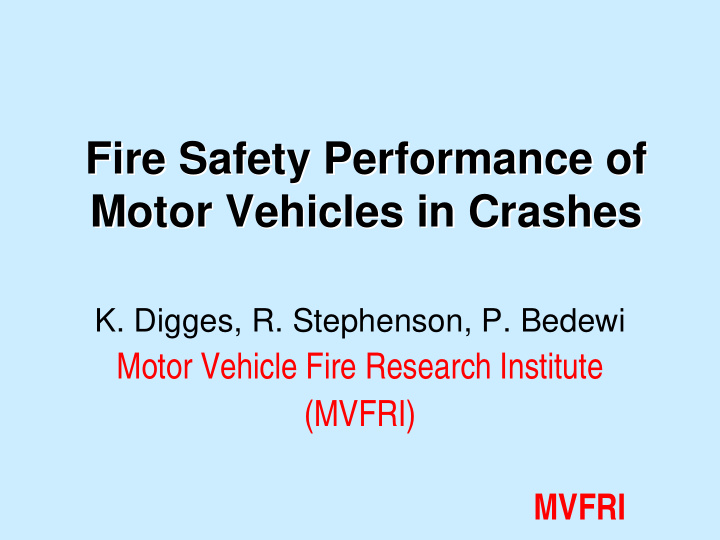



Fire Safety Performance of Fire Safety Performance of Motor Vehicles in Crashes Motor Vehicles in Crashes K. Digges, R. Stephenson, P. Bedewi Motor Vehicle Fire Research Institute (MVFRI) MVFRI
MVFRI www.mvfri.org www.mvfri.org
Presentation Outline • Who is MVFRI? • Selected Research Projects • Selected Results – Frequency of fires – Plastic Fuel tank test results • Conclusions • Future Research MVFRI
MVFRI - Charter • The Motor Vehicle Fire Research Institute (MVFRI) is an independent, nonprofit, organization specializing in automobile fire safety research. • MVFRI performs objective research to develop and implement successful technology to reduce the incidence of injuries and death resulting from post-collision fuel fed fires in existing and future designs of passenger vehicles . MVFRI
Background of Research • From 1995-2000 GM funded $10 million in fire research in a GM/DoT Settlement of an investigation of an alleged defect in C/K pickup trucks • Beginning in 2001 GM began funding $4.1 million in fire related research as result of a judicial settlement of the alleged defect • This research is being administered by MVFRI MVFRI
Selected MVFRI Projects • Statistical analysis of field data • Evaluation of US fuel tanks to ECE & other standards MVFRI
Analysis of Field Data • FARS 1979-2000 • Vehicle age 0-4 years • Occupants of vehicles where fire/explosion was most harmful event Output: • Fatality counts and • Fatality rates per million vehicle registered years MVFRI
Fatality Counts - Fire/Explosion as Most Harmful Event 250 200 Fatalities 150 100 50 0 1981 1983 1985 1987 1989 1991 1993 1995 1997 1999 1979 Cars Pick-ups Vans SUVs MVFRI
Fatality Rates - Fire/Explosion as Most Harmful Event 12.0 Fatalities / Million Vehicle Years 10.0 8.0 6.0 4.0 2.0 0.0 1979 1981 1983 1985 1987 1989 1991 1993 1995 1997 1999 Cars Pick-ups Vans SUVs MVFRI
Observations • Number of fatalities from fire/explosion decreased by 65% since 1979 • Overall fatality rate from fire/explosion decreased by 72 % since 1979. • Average fatality rate, (all vehicle classes) for last 5 years > 2.0 per million vehicle years MVFRI
NASS Fires by Impact Direction Roll 24% Front Rear 52% 6% Side 18% Frontal impact is most frequent mode Rollover is Number 2 MVFRI
NASS Fires by Fire Origin Unknown Interior 17% 4% Exterior 3% Engine Fuel Tank Compart. 11% 65% Engine compartment fires are most frequent MVFRI
Evaluation of Plastic Tanks Tanks subjected to tests from 3 standards: • ECE R 34 – 2 minute pool fire • ECE R 34 – -40 o C impact test • CFR 393.67 – 30 ft. drop test MVFRI
Evaluation of Plastic Tanks 3 Shapes Long narrow New tanks and Square “conditioned” tanks were tested Pancake MVFRI
ECE R34 – Pool Fire Test Requirement: No leakage during 1 minute high intensity fire 1 minute of low intensity fire MVFRI
Test Results •ECE – Cold Impact - All Satisfactory •ECE – Pool Fire - Generally Satisfactory Long Tank Post Fire Test • CFR 393 – Drop Test – New Tanks OK – Seasoned Tanks 2 of 3 leaked at pinchoff Long Tank Post Drop Test MVFRI
Other Ongoing Research • Tests of seasoned tanks at pinch-off joint • State-of-the-art of fire safety technology • Carbon tracking properties of insulators for 42 volt systems (with USCAR) • Toxicity of under-hood materials (supplement to NHTSA project) MVFRI
Conclusions – Accident statistics • Deaths and death rates from fires in new vehicles decreased by about 2/3 since 1979 • Rates have remained fairly constant during the past five years • Fires most frequently occur in frontal crashes, followed by rollovers • The most frequent fire source is the engine compartment MVFRI
Conclusions – Plastic Tank Tests • The new and seasoned plastic tanks tested to date performed reasonably well in ECE pool fire and cold impact tests • Seasoned tanks may have a weakness at the pinch-off that is not exhibited in new tanks MVFRI
Future Research • Summary and synthesis of $10 million GM/DOT Fire Research Projects • Benefits of selected technologies to reduce vulnerability to fires • Optimum fuel tank location and protection • Component tests for fuel tanks • Benefits of delayed fire penetration time MVFRI
Future Research (Continued) • Ignition properties of automotive materials exposed to 42 volt arcing • Safety issues for hydrogen fueled vehicles. MVFRI
MVFRI Visit our website www. mvfri.org
RECOMMENDATION: We propose that RECOMMENDATION: We propose that there be a Fire Safety Session at the there be a Fire Safety Session at the 2005 ESV Conference 2005 ESV Conference ----------------------------------------------- ----------------------------------------------- The End The End Questions? MVFRI
Recommend
More recommend